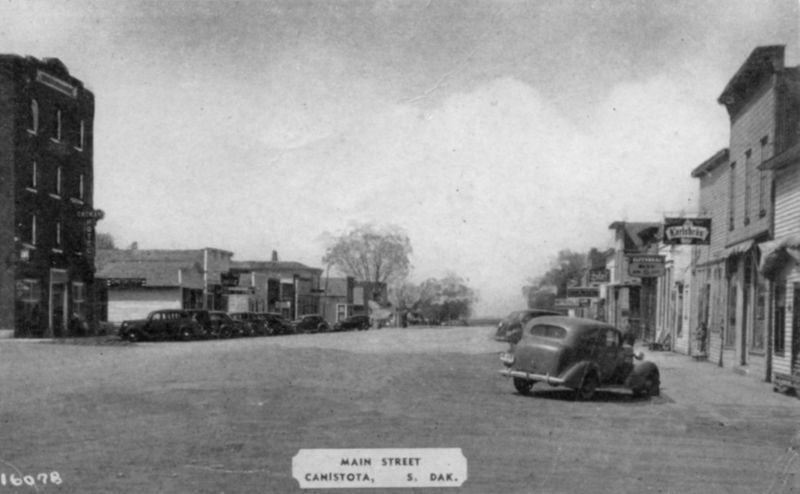 |

| |
|
|  |
Bemidji At Night, 1916.
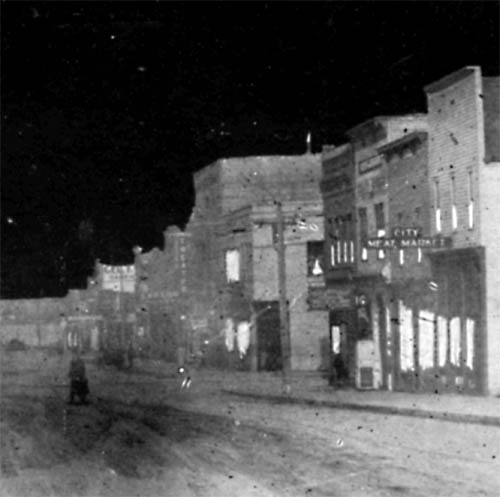
Click for full image Bemidji, Minnesota: home of Paul Bunyan and Babe the Blue Ox, but the giant pair were still twenty years away when this postcard was mailed in 1916. In the 1910s, it was still a community on the grow, trying to develop roads and railroad access. A new depot was built a few years earlier than when this postcard was mailed and railway passengers were probably one of the main customers of such mementos of midwest travels. Cameras of the time were not particularly efficient at night, so this photo was probably a daytime photo that was underexposed and colored to make it look like 'night'. In the 1910s, Either Third street has changed significantly, or the view is from a different spot: Google Maps doesn't help. Labels: 1910s, 1916, bemidji, minnesota history, postcard
Angelo's Place - Gulfport Mississippi
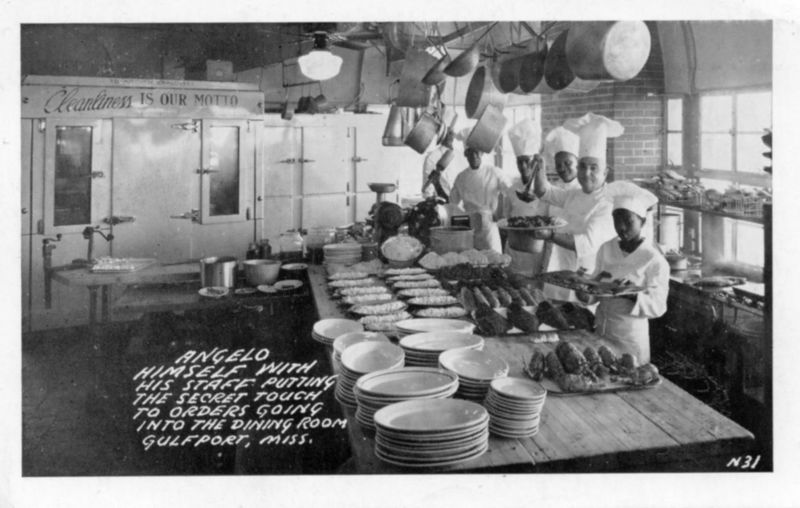 The postcard assumes you know who Angelo is -- this fine chef was so ubiquitous that his first name was enough to tell all who he is. Emeril? Bah -- television was his tool...Angelo was known by word-of-mouth! This postcard is done in the style of real-photo postcards from the 1910s to 1930s, but appears to have been printed much later (and it's not actually a photographic copy). Angelo Xidis immigrated as a teen in 1915, opening his eponymous restaurant in 1935. This would seem to be about the right time for this photo, maybe 1940s. Sadly, Angelo's closed in the 1980s, well after the original Angelo retired, but the restaurant lives on in the numerous postcards that recommended his restaurant to the friends and relatives of a multitude of Mississippi vacationers. Labels: 1940s, angelo's place, gulfport, mississippi, postcard, restaurant
The Best Of Friends
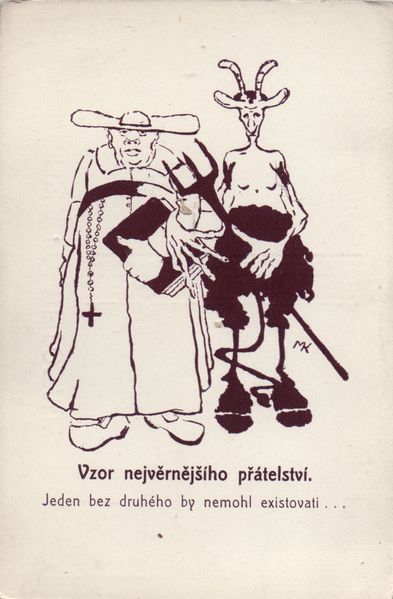 This This is the last of the atheistic Freethought postcards I got at an antique show a few months ago. It's the least witty or thoughtful of the three, but it was the hardest to translate. We've got a priest and a devil, arm in arm, looking a little displeased, but neither is fighting it. The first line reads, "Example of an extreme friendship"; the second says, "A pair who exist due to afflictions." This sentiment is similar to the first card, an attitude that the church preys on people who aren't giving their condition enough thought and trusting in religion. It's an odd thing to be anti-church, while using the church's boogey-man as the reson for the comparison, but, hey, it works. Me, I personally really like the stylized devil he drew -- in today's modern culture, we almost universally show a "Mephistopheles Dracula", a red-skinned suave gentleman with a van-dyke beard, stylish cape, and tiny horns on the forehead. Or, we depict Satan like the Incredible Hulk, with huge teeth and bulging muscles. This Czech devil (probably intentionally) looks ill and weak. A fat, well-fed cleric and an impotent devil? That probably meant more than a weak analogy. Labels: 1900s, 1907, church, czech, devil, postcard
Church Criticism In Czech Scripture
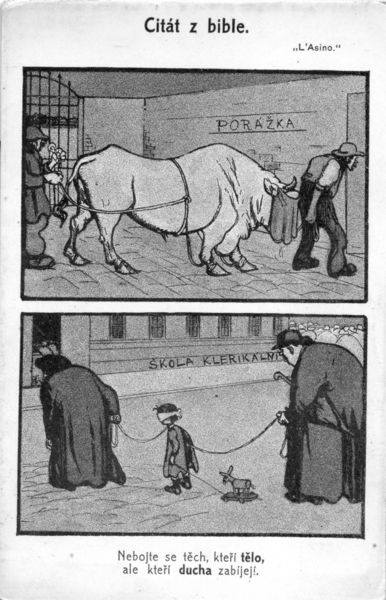 Last week's postcard Last week's postcard got a lot of attention thanks to SPS (nsfw), so here's card #2. This appears to hail from the same time-period, but isn't postmarked or dated like the previous card. The top line says, " Quotation From Scripture", and the bottom reads, " So fear those who slaughter the body and the soul." Like a bull to slaughterhouse ( porážka), a child is taken in for religious education ( škola klerikálni). The blindfold on the bull is used to keep it calm when leading it to slaughter; the child is also being taken 'blindfold to the abattoir,' oblivious to the harm approaching. Even without understanding Czech, the image is powerful without the direct accusation of destroying body and soul. The quote isn't right, though; I compared to several Czech translations available online, and the quote is similar to Matthew 10:28, which says not to fear enemies who can destroy the body, instead fear what God can do to your soul in Hell. By changing word-placement, the maker of this card accuses the clergy of making a Hell on earth for students left in their care. I've read up a bit more on what group would be so critical of the church to produce these editorial cartoons so publicly. At the time, turn-of-the-20th-century, the Freethinkers were a prominent group in Czech life, growing from Bohemia and anti-Hapsburg sentiment. The Czech regions, ruled by Austria, were made Catholic states, and popular sentiment began to turn anti-church by the mid-19th century. The Hapsburgs rule ended, and the regions gained more autonomy through the end of the 19th century. Marxism and socialism were developing as social, non-governmental movements, the Freethought movement was very popular amongst the religion-suspicious populous. These postcards were popular-sentiment status quo for the young independent, Bohemian Czech Republic. Labels: 1900s, anti-religious, czech, postcard
The Fear Of Death
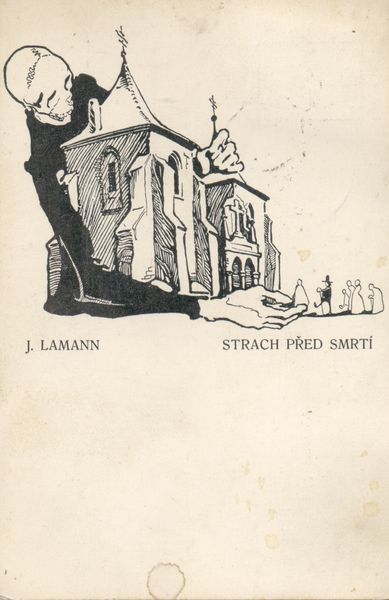 I bought a couple of these interesting postcards at a antique show recently. The drawings caught my eye, but the messages on them are a bit more striking as I've been figuring out what they say. They date from the very early 20th century -- this one from 1909 -- and they are all blatantly anti-religious, focusing on Christianity. This one doesn't directly target the church itself, but the followers. The phrase " strach před smrtî", as closely as I can translate, means " The fear of death." To believe in something solely over fear of your eternal soul, the producer of this card believes, is a poor choice for faith. I'm still researching the postcards' origins: they seem too early to be Communist, but religious opposition had many sources in that period. I should know a little more as I get to the other cards in the future. Labels: 1900s, 1909, anti-religious, czech, postcard
|  |
|
|












